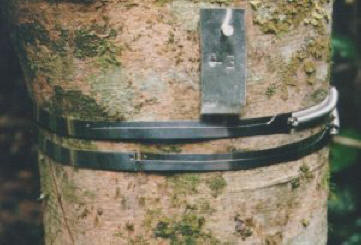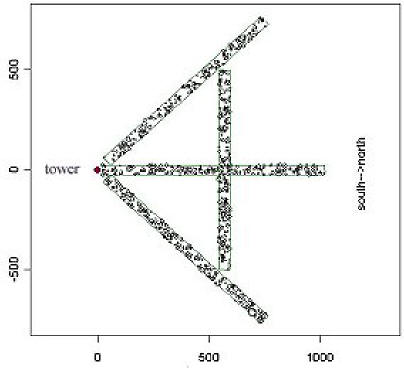Get Data
Summary:
This data sets reports biometry measurements of the old-growth upland forest at the Pará Western (Santarém) - km 67, Primary Forest Tower Site. This site is in the Tapajos National Forest located in north central Brazil. Measurements extend from July 1999 through March 2005.
To monitor tree woody increment, metal dendrometer bands (Figure 1) were placed on a sub-sample of 1000 trees in December 1999. The data set contains estimates of tree diameter at breast height (cm) based on caliper measurements made approximately every six weeks. The first column of data refers to the tree identification number. For a more detailed description of the biometry study refer to Rice et al. 2004.
The data file contains a time series of DBH (cm) values from July 1999 through March 2005.

Figure 1. Dendrometer bands wrap like a belt around a tree at breast height. A spring secures the ends and two measuring points are punched where the band overlaps. An initial diameter at breast height is recorded for each tree. As the tree grows, the spring stretches, and the measuring points are pulled apart. By measuring this increasing distance between points, we can accurately determine the increase in the tree’s diameter. Most trees have only one dendrometer, but this tree was being used to test different dendrometer styles.
Data Citation:
Cite this data set as follows:
Rice, A. H., E. P. Hammond, S. R. Saleska, L. Hutyra, M. Palace, M. Keller,P. B. de Carmargo, K. Portilho, D. Marques and S. C.Wofsy. 2007. LBA-ECO CD-10 Ground-based Biometry Data at km 67 Tower Site, Tapajos National Forest. Data set. Available on-line [http://www.daac.ornl.gov] from Oak Ridge National Laboratory Distributed Active Archive Center, Oak Ridge, Tennessee, U.S.A. doi:10.3334/ORNLDAAC/854
Implementation of the LBA Data and Publication Policy by Data Users:
The LBA Data and Publication Policy [http://daac.ornl.gov/LBA/lba_data_policy.html] is in effect for a period of five (5) years from the date of archiving and should be followed by data users who have obtained LBA data sets from the ORNL DAAC. Users who download LBA data in the five years after data have been archived must contact the investigators who collected the data, per provisions 6 and 7 in the Policy.
This data set was archived in May of 2008. Users who download the data between May 2008 and April 2013 must comply with the LBA Data and Publication Policy.
Data users should use the Investigator contact information in this document to communicate with the data provider. Alternatively, the LBA Web Site [http://lba.inpa.gov.br/lba/] in Brazil will have current contact information.
Data users should use the Data Set Citation and other applicable references provided in this document to acknowledge use of the data.
Table of Contents:
- 1 Data Set Overview
- 2 Data Characteristics
- 3 Applications and Derivation
- 4 Quality Assessment
- 5 Acquisition Materials and Methods
- 6 Data Access
- 7 References
1. Data Set Overview:
Project: LBA (Large-Scale Biosphere-Atmosphere Experiment in the Amazon)
Activity: LBA-ECO
LBA Science Component: Carbon Dynamics
Team ID: CD-10 (Wofsy / Kirchhoff)
The investigators were Hutyra, Lucy; Pyle, Elizabeth Hammond; Wofsy, Steven C. and Saleska, Scott R. . You may contact Hutyra, Lucy (lrhutyra@u.washington.edu) and Hammond-Pyle, Elizabeth (pyle@fas.harvard.edu)
LBA Data Set Inventory ID:CD10_Biometry_Tapajos
Tree growth measurements based on repeated dendrometer band measurements at the km67 flux tower site, Tapajos National Forest, Santarem, Para, Brazil.
For additional information, please see the following web sites: Harvard University,Cambridge, MA, USA -- LBA Web Page
(http://www-as.harvard.edu/data/lbadata.html)
These data may be updated or reprocessed from time to time, and it is your responsibility to insure that your publication contains the most recent revision of the data.
Related Data Sets:
LBA-ECO CD-10 H2O Profiles at km 67 Tower Site, Tapajos National Forest
LBA-ECO CD-10 CO2 Profiles at km 67 Tower Site, Tapajos National Forest
2. Data Characteristics:
The biometry data are reported in one tab-delimited ASCII text file.
The data file contains a time series of DBH (cm) values from July 1999 through March 2005. In addition to initial measured values, DBH was calculated as the sum of the increment measured by the dendrometer band and the initial DBH of each tree. NAs in the data set are due to tree mortality. A lowess (locally weighted least squares, http://www.itl.nist.gov/div898/software/dataplot/refman1/ch3/lowess_s.pdf) smoothing algorithm was applied to fill short gaps in the data set. Therefore, a small subset of the reported values were calculated but these values have not been marked in the data file.
Data File Documentation:
| Data Columns: Description id: tree identification number T: transect number Tag: tree tag number common.name: tree common species identification family: botanical family genus: botanical genus spp: scientific species identification x: x coordinate location y: y coordinate location ht: visually estimated height Ni: initial variable for sample stratification (7/1999), see page S59 in Rice et al. 2004 Bi: initial variable for sample stratification (7/1999), see page s59 in Rice et al. 2004 Ai: initial variable for sample stratification (7/1999), see page s59 in Rice et al. 2004 DOYsince1999.196Column names are the Dendrometer Measurement dates in Julian days counting from 1/1/1999. ... The values reported are the Tree Diameter Measurement in centimeters. DOYsince1999.489 ... DOYsince1999.2280 NAs in the data set are due to tree mortality. |
Sample Data Record:
All of the biometry data are reported in lba_km67_dend_dbhs_filled_archive.txt.
id,T,Tag,common_name,family,genus,spp,x,y,ht,Ni,Bi,Ai,DOYsince1999.196,DOYsince1999.345,DOYsince1999.414, DOYsince1999.445,DOYsince1999.489,DOYsince1999.551,DOYsince1999.592,DOYsince1999.634, DOYsince1999.678,DOYsince1999.702,DOYsince1999.775,DOYsince1999.810,DOYsince1999.838, DOYsince1999.873,DOYsince1999.914,DOYsince1999.950,DOYsince1999.992,DOYsince1999.1029, DOYsince1999.1075,DOYsince1999.1103,DOYsince1999.1129,DOYsince1999.1159,DOYsince1999.1195, DOYsince1999.1230,DOYsince1999.1271,DOYsince1999.1299,DOYsince1999.1327,DOYsince1999.1356, DOYsince1999.1385,DOYsince1999.1412,DOYsince1999.1446,DOYsince1999.1481,DOYsince1999.1506, DOYsince1999.1547,DOYsince1999.1581,DOYsince1999.1632,DOYsince1999.1657,DOYsince1999.1709, DOYsince1999.1733,DOYsince1999.1762,DOYsince1999.1799,DOYsince1999.1825,DOYsince1999.1855, DOYsince1999.1888,DOYsince1999.1982,DOYsince1999.2063,DOYsince1999.2099,DOYsince1999.2127, DOYsince1999.2168,DOYsince1999.2197,DOYsince1999.2280 **Line Breaks Added to Improve Readability NAs in the data set are due to tree mortality. |
Site boundaries: (All latitude and longitude given in degrees and fractions)
| Site (Region) | Westernmost Longitude | Easternmost Longitude | Northernmost Latitude | Southernmost Latitude | Geodetic Datum |
|---|---|---|---|---|---|
| Para Western (Santarem) - km 67 Primary Forest Tower Site (Para Western (Santarem)) | -54.959 | -54.959 | -2.857 | -2.857 | World Geodetic System, 1984 (WGS-84) |
-
Time period:
- The data set covers the period 1999/07/15 to 2005/03/29.
- Temporal Resolution: every four to six weeks
-
Platform/Sensor/Parameters measured include:
- FIELD INVESTIGATION / STEEL MEASURING TAPE / BIOMASS
3. Data Application and Derivation:
Stainless-steel dendrometer bands
4. Quality Assessment:
Note: The dendrometers were placed on a random subsample of 993 trees, stratified by taxonomic family and size class. This sampling strategy ensured that all size classes and the full taxonomic diversity were sampled. Due to the stratified nature of the sample, a simple area expansion can not be applied. Please see Rice et al. 2004 for a more detailed explanation. Contact the investigators if you would like the full sample expansion information.
5. Data Acquisition Materials and Methods:
Dendrometer band increments, or expansion of the bands with tree growth, were measured every 4 - 6 weeks using electronic calipers, allowing detailed examination of variation in seasonal growth rates. For the dendrometer survey, dbh was determined as the addition of the increment measured by the dendrometer to the initial dbh for each tree. The 1000-tree dendrometry subsample can be scaled up to per unit area flux (G, in Mg C ha^-1 yr^-1) methods described in Rice et al. 2004.

Biomass Survey In July of 1999, we surveyed 20 ha of forest in the tower "footprint." Over 2500 trees were measured, identified and mapped in four transects (1000m) east of the tower. Overall, trees were distributed among ~260 species within ~50 families. Common species encountered include Manilkara huberi, Coussarea racemosa, Sclerolobium chrysophyllum, Protium sp., Couratari stellata and Erisma uncinatum.
Stainless steel dendrometer bands were placed on a random subsample of 1000 trees, stratified by taxonomic family and size class, in December 1999. The 48 identified taxonomic families were divided into five size classes (10–<22.5, 22.5–<35, 35–<55, 55–<90, and >=90 cm dbh). We included all individual trees in the largest size class (>=90 cm dbh), because large trees account for a major portion of aboveground biomass in neotropical forests (Brown et al. 1995, Clark and Clark 1996). The rest of the sample was drawn randomly from the remaining size-class–taxonomic family categories. This sampling strategy ensures that all size classes and the full diversity of life-history traits (as represented by taxonomic family) were sampled, but avoids repetitively sampling the large number of stems in smaller subgroups that have more limited influence on carbon balance. We banded a large number of trees with the goal of obtaining high-resolution growth measurements that could be correlated to precipitation or seasonality with errors < 10%.
-
Sensors used include:
- STEEL MEASURING TAPE
6. Data Access:
This data is available through the Oak Ridge National Laboratory (ORNL) Distributed Active Archive Center (DAAC) or the EOS Data Gateway.
Data Archive Center:
Contact for Data Center Access Information:
E-mail: uso@daac.ornl.gov
Telephone: +1 (865) 241-3952
FAX: +1 (865) 574-4665
7. References:
Rice, A.H., Hammond, E.P., Saleska, S.R., Hutyra, L., Palace, M., Keller, M., de Carmargo, P.B., Portilho, K., Marques, D., Wofsy, S.C. 2004. Carbon Balance and Vegetation Dynamics in an Old-growth Amazonian Forest. Ecological Applications, 14 (4), s55-s71.
Brown, I. F., L. A. Martinelli, W. W. Thomas, M. Z. Moreira, C. A. C. Ferreira, and R. A. Victoria. 1995. Uncertainty in the biomass of Amazonian forests: an example from Rondonia, Brazil. Forest Ecology and Management 75: 175–189.
Clark, D. B., and D. A. Clark. 1996. Abundance, growth, and mortality of very large trees in a neotropical lowland rain forest. Forest Ecology and Management 80:235–244.
Related Publications
- Rice, A.H., E.H. Pyle, S.R. Saleska, L. Hutyra, M. Palace, M. Keller, P.B. de Camargo, K. Portilho, D.F. Marques, and S.C. Wofsy. 2004. Carbon balance and vegetation dynamics in an old-growth Amazonian forest. Ecological Applications 14(4):S55.